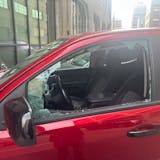More than two-thirds of Minnesotans say they won't return to normal rhythms of daily life even though some social distancing restrictions have been relaxed, and many believe the worst of the coronavirus pandemic is yet to come, according to a new Star Tribune/MPR News/KARE 11 poll.
As anxiety about the virus persists, the poll also found a majority of people support the stay-at-home restrictions and business closures they lived under for nearly two months and say they were necessary to limit the spread of the virus in their communities.
In the poll of 800 registered voters — conducted May 18 through May 20 — 57% of respondents said the restrictions are the right approach to prevent the coronavirus from spreading, while 32% said they have gone too far. Only 9% said the restrictions did not go far enough. Despite partisan divisions, a majority of independents also support the restrictions.
"The rest of them can do whatever they want, but I try and protect myself," said Gary Lenius, who lives in Two Harbors and supports the restrictions because he's 78 and at a higher risk of severe illness if he catches the virus. Plus, he said, staying at home fits his lifestyle. "I'm not going to go out and run around, I'm going to play it cautious and wait and see and take my time. That rocking chair fits quite well by this time."
The Mason-Dixon poll, which has a 3.5% margin of error, comes as DFL Gov. Tim Walz begins to slowly turn the dial on a stay-at-home order that, for 51 days, shuttered noncritical businesses and asked Minnesotans to stay inside except for essential needs and services. That order was lifted on Monday and replaced with a new measure that allows Main Street businesses and retailers to open their doors, while still limiting group gatherings to no more than 10 people.
Under a separate order, bars and restaurants in the state have been closed for dine-in services since March 17, as have movie theaters, gyms, hair salons, concert venues and other public spaces that put people in close contact. Starting June 1, Walz said restaurants and bars can start serving up to 50 patrons outdoors and hair salons and barbershops can reopen at 25% capacity, as long as employees and customers wear masks.
Support for Walz's restrictions is higher among women, people living in Hennepin and Ramsey counties and those who identify as Democrats. But strong support for the restrictions was found statewide, not only in urban areas. A majority of independents also back the restrictions, with 60% saying they're about right or don't go far enough, compared with 37% who said they've gone too far.
Statewide, 65% of Republicans say the restrictions have gone too far. Walz's orders also have come under sharp attack from conservative groups and GOP lawmakers in the Minnesota Legislature, who argue they've been applied unevenly and will lead to a devastating economic downturn. Since March, about 700,000 Minnesotans have filed for unemployment benefits.


